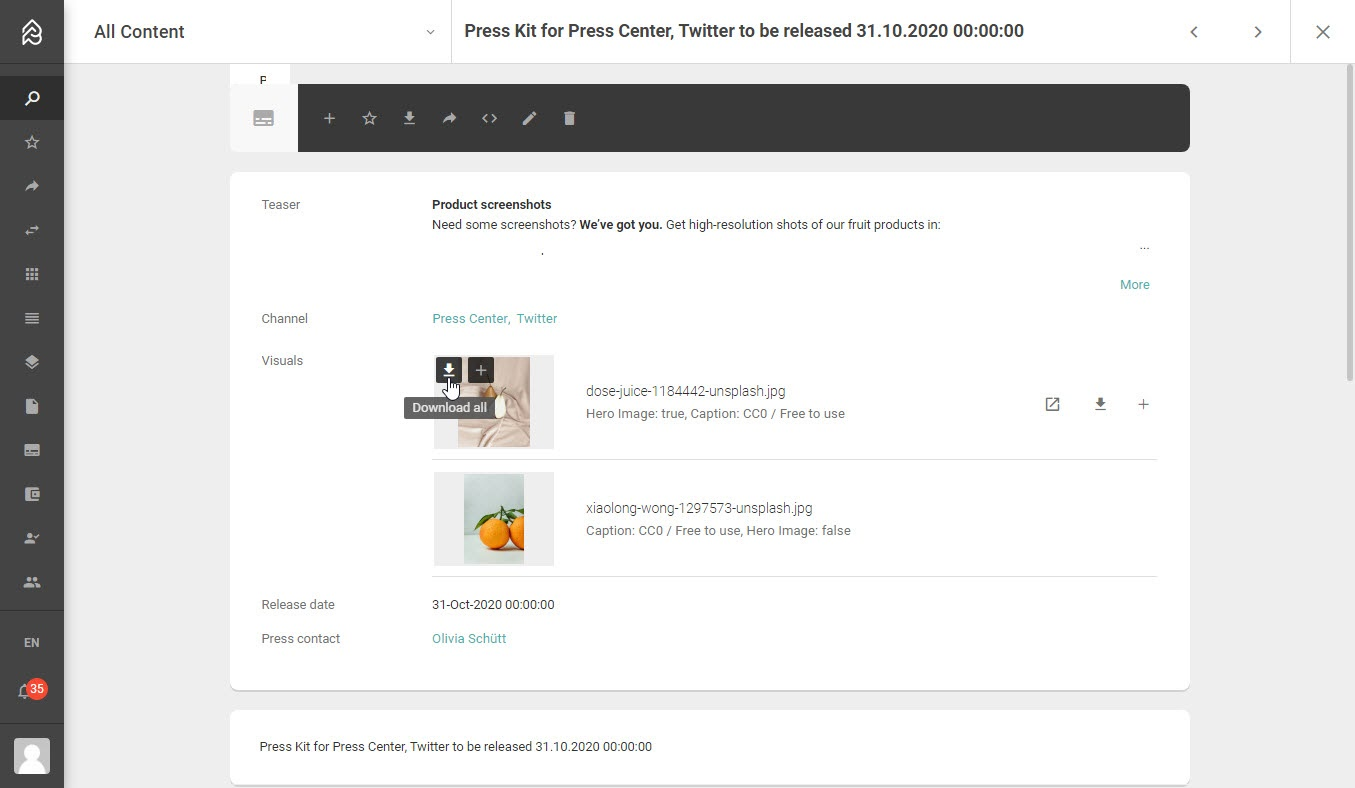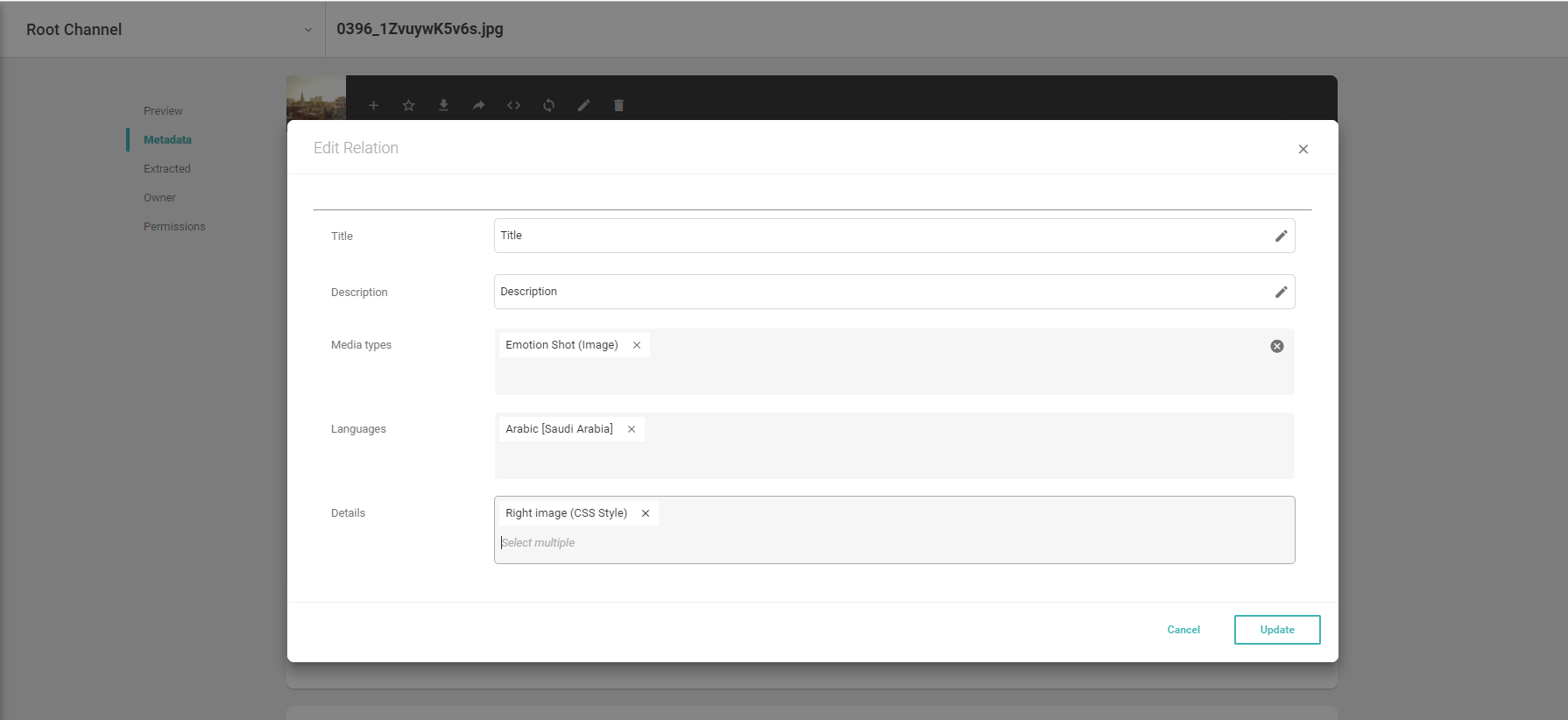Relationship
The Relationship field allows relating content to other content, similar to hyperlinks (links) on the internet, and is especially useful for creating press kits, print packages, and landing pages by adding related visual content. For a press kit, you can link the hero image and the Logo.
Relationship Overview
Icon |  |
Behavior | VIDEO: How Relationship Behaves You select Content Items based on the Query Filter of the Field. On assignment, you must provide information about the relationship between the assigned and the original content. The underlying relationship schema defines which relationship information you must provide. |
Pre-Requirement | Before creating a Relationship Field, you must create the schema used for providing information about the relationship. This schema shows up when assigning a Content Item in this field. |
Parent-Child Setup | You can create a schema "Relationship" following a parent-child setup. When you connect your Relationship schema to the Relationship field, the parent-child hierarchy is ignored. If you connect the Relationship field to a parent, you will only see fields on the parent. If you connect the Relationship field to a child, you will only see fields on the child, no propagated fields from the parent. |
Batch Actions:
| Related content items can be downloaded all together or placed all together in the basket for further processing, e.g., editing or sharing. Additionally, each individual item can be downloaded directly or added to the basket.  |
Limitation | Relationship Fields are not available in Batch Editor! You can not edit a single or multi relationship in the Batch Editor batch edit mode (only in single edit), nor Excel Roundtripping App. You can easily edit them via API. Furthermore, Content Items or List Items cannot be sorted based on Relationship fields. |
Display pattern | Picturepark does not use the Display Pattern on the Relationship Schema. All relationship information in the view mode of a Content Item is hard-coded and does not consider Display Patterns. |
Single Relationship | One item can be related. Examples are:
|
Multi Relationship | Multiple items can be related. Examples are:
|
Display & Handling | The relationship field items are displayed as a list or thumbnails small or medium. The elements can be re-arranged if you have edit permissions on the Content Item and view permissions on the related Content Items. |
Permissions | Inside a relationship field, the Content Item permissions apply. For example, if you have a user who cannot view a Content Item in a relationship field, they will get this view:  However, double-clicking on that field will allow them to view the relationship details - when the layer is visible thanks to the View for all permission for the relationship schema.  |
Examples | On a Content item for a product, you might have a Relationship field for product photos. In your relationship schema for this field, you might have a single field for View that is, in turn, assigned to a List that provides the Front, Top, and Side values. When a user relates a photo to the product Content Item, the field for View will appear, enabling the user to define the context of the related image. When the Content Item was published, this contextual information would be available. Another valid approach is to use the Relationship field to relate creative files. Whether you are linking the zip package or individual files is up to you. In addition, your relationship schema could include fields for Caption or any other context information about the related content. |
Relationship Value Handling
Picturepark Setup Example | Layer: Corporate Information (ID: CorporateInformation) |
Fieldpath | corporateInformation.corporateLogo |
Advanced search for field | _exists_:corporateInformation.corporateLogo
|
Use in Display Pattern |
|
Returned field value options | Single:
|
Returned field value | The field itself does not return values. You must access the individual values per option (e.g., data.corporateInformation.corporateLogo.mediaType) |
Relationship Field Settings
Name | The Name setting is available for various items in Picturepark, for example, fields, schemas, and business rules. This value defines what appears in the Picturepark interface. You can change the name anytime and translate it into any configured metadata language. To add a translation for the name, select Add.
|
ID | The ID field is the ID of your field, which is used to link to this field. The field ID is always lowercase. The field's ID is set when creating a new field using camel casing. You need the field ID for the configuration of filters or display patterns. The ID is automatically created from the name you insert:
 You can open the Display Pattern Editor to see the JSON of a Content Item. |
Single item relationship | Allow one or multiple data entries into the Relationship Field. You cannot change this setting once saved. |
Relationship name | The name of the relationship you create when assigning a Content Item. |
Relation ID | Constructed from the name by removing spaces and special characters. |
Relationship type | The type of items you can assign in the Relationship Field. Currently limited to Content Items only. |
Relation | The underlying schema used to insert information about the relation, e.g., a schema with two fields for legend title and description, which you must fill out when relating a hero shot. |
Item filter | Limit the Content Items available for selection by using a filter, e.g., only show logos. |
Minimum | Only whole numbers (integers) are supported. By adding a minimum value, you set the field required. |
Maximum | Setting the maximum value to 1 turns a multi-item relationship into a single-item relationship; however, we recommend choosing a single item relationship instead. |
Required | This ensures that at least one item is always related e.g. for press kits the hero shot or the logo. The minimum value fulfills the same purpose, but we recommend using the correct required flag for the desired required option. |
UI required | The UI required field setting determines whether or not an editor must provide a field value to save the Content Item in the UI. If a field is UI required and the user has not provided a value or deleted the existing value, Content Platform does not permit saving the item in the UI. This value can be changed at any time. |
Default view | Select the default view for related items:
|
Show related content on download | Show the related Content Items in the download window. Show related content on download is not available for List Schemas. |
List view maximum rows | Select the maximum rows that should be displayed in the list view. The default is set to 4. |
Thumbnail view maximum rows | Select the maximum rows that should be displayed in the thumbnail view. The default is set to 2. |
Include in filters | Picturepark uses indexing settings from the relation schema. |
Include in search | Keep in mind that Picturepark does not index metadata of the related content e.g., all the Product Information or an assigned Media Type. Only the relationship information given on the assignment of a Content Item is indexed. |
Boost value | The Boost factor field setting will boost the values in the search and help you define the relevance of the content for your users. The boost parameter increases the relative weight of a term (with higher boost values) or decreases the relative weight (with lower boost values), but the increase or decrease is not linear. In other words, a boost of 2 does not result in double the score. You can select between 1, 10, 25, 50, 100, or 500.
Picturepark checks this setting against the allowed number of Search-indexed fields in your subscription plan. While it may be tempting to include all fields in filters and simple search boosting them, you may revisit this idea based on your subscription plan limit. |
